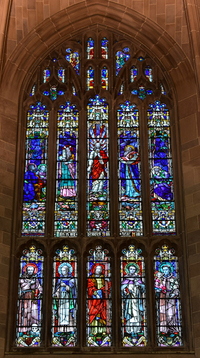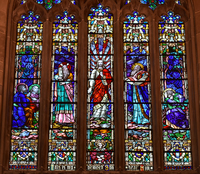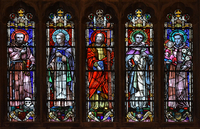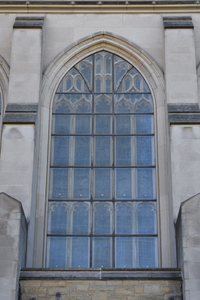Window
Building Name: Cathedral of the Most Blessed SacramentStudio Name: Willet Hauser Architectural Glass
City: Detroit
Window Shape: 6 (gothic arched, more than 2 vertical sections)
Subject/Title of Window: The Transfiguration
Brief Description of Subject: The canopy topping this five panel window is decorative in nature highlighted by angels with a censer.
The scene below is topped with decorative inscriptions based on Matt; 28:2-5 --- the resurrection scene where the two Mary's had come to anoint the body of Jesus and an angel appeared at the tomb "And for fear of him the guards trembled and became like dead men. But the angel said to the women 'Don't be afraid, for I know you seek Jesus." The Transfiguration is covered in the Gospels of Matthew, Mark, and Luke. The "Guide to the Cathedral of the Most Blessed Sacrament" gives an excellent description of the scene (see last paragraph). Just some comments. The inscription "This is my beloved Son, hear him" is Mark 9:7. Moses received the ten commandments on two tablets, when seen, as here, they are usually broken down as 4 on one tablet and 6 on the other. This reflects that the first four pertain to God, while the last six pertain to man. "Elias" is the Greek name for the Hebrew name "Elijah." Elias is holding an open scroll which symbolizes that he is a prophet --- this comes from Ezekiel 2:9-10. Ezekiel heard the voice of God telling him to stand up and then a hand (God's) was stretched out to him; a scroll was in it and when it was spread out it contained a prophecy. Below the scene are decorative coats-of-arms as befitting a Norman styled church as well as an angel holding what looks like a menorah atop a book.
In the lower portion of the window is depicted five saints with the artist' creation of their coat-of-arms.
Francis of Assisi (1181 - 1226) renounced all material possessions and was directed by Christ to repair an abandoned chapel called "St. Mary of the Angels". He lived in the chapel and was joined by many followers which led him to found the "Order of Friars" aka "Franciscans". In 1224 while staring at a cross he received the stigmata. He is known for his many writings. His love of the natural world led him to write "The Canticle of Brother Sun and Sister Moon". He had a special devotion to the Virgin Mary; many years after his death, a Franciscan friar initiated the seven decade rosary based on the seven joys of Mary -- it is called the "Franciscan Crown" and is worn by Franciscans. His attributes seen here include tonsured (religious devotion and humility), dressed in the habit of a Franciscan friar -- including a rope cincture with knots and a rosary, a book, a cross, a skull (symbol for a penitent saint), and "brother sun" in the coat-of-arms.
St. Bernard (1090 - 1153) founded the monastery at Clairvaux in 1115 and was its abbot for the rest of his life. He is especially known for his many writings, sermons, devotion to the Virgin Mary, fight against heresy, and early promoter of the Knights Templar. He became a Doctor of the Church in 1830. His attributes seen here are tonsured (religious devotion and humility), garbed as a Cistercian monk including their white monastic scapular, quill pen, and book. I was not able to identify the objects in his coat-of-arms.
St Thomas was one of the Apostles best remembered as the "Doubting Thomas" for his denial of the resurrection unless he placed his fingers in Christ's wounds. When Christ did appear to him, he proclaimed "my Lord and God". He preached and proselytized in India where he is reputed to have built a church. His attributes seen here include a book (Word of God) and what looks like a processional cross (follower of Christ). I was not able to identify the objects in his coat-of-arms.
St. Dominic Guzman (1170 - 1221) is best known as a great preacher and the founder of the "Order of Preachers" popularly called "Dominicans." He had a special devotion to the Virgin Mary and is credited with standardizing the Rosary. There is a legend that in 1530 the Virgin Mary appeared to a Dominican friar and told him she wanted St. Dominic to be pictured holding a lily and a red book. His attributes seen here include costumed as a Dominican including a rosary, holding a lily and a red book. I was not able to relate the objects in the coat-of-arms to St. Dominic. The white barking dog seen in the coat-of-arms is an attribute of St. Bernard -- in a prenatal dream, his mother saw a white barking dog which was interpreted to mean that when the child (St. Bernard) grew up he would faithfully guard Christianity, barking against its enemies.
St. Anthony of Padua (1195 - 1231) was baptized with the name "Fernando" but when he joined the Franciscan Order at their abbey dedicated to St. Anthony of Egypt", he changed his name to "Anthony". He was known for his preaching and teaching of theology and in 1946 was named a Doctor of the Church. While St. Anthony was on his death bed, a friar asked him "What are staring at" and St. Anthony replied "The infant Jesus". His attributes seen here include pictured as a tonsured Franciscan monk, staring at the infant Jesus, a book (preached the Word of God), and a lily (chastity). His coat-of-arms contains a frog --- it was told that near the monastery there was a large pond that contained many frogs; their croaking was disturbing the friars but when St. Anthony blessed the frogs they stopped their croaking.
From the Guide to the Cathedral of the Most Blessed Sacrament, Copyright 1958, Archdiocese of Detroit.
Here stands the Lord, transfigured with the glory that is rightfully His. To His immediate right is Moses and to the left Elias. On the extreme left are James and John, overcome by the glory before their eyes. On the extreme right is St. Peter, equally dazzled by the splendour that radiates from the Redeemer. In the lower panels are St. Francis of Assisi, St. Bernard, St. Thomas the Apostle, St. Dominic, and St. Anthony.
Inscriptions: This is My Beloved Son hear Him
Height: 25'
Width: 12'
The Transfiguration
The Transfiguration scene
The Transfiguration, Saints
The Transfiguration outside
The MSGC is a constantly evolving database. Not all the data that has been collected by volunteers has been sorted and entered. Not every building has been completely documented.
All images in the Index are either born-digital photographs of windows or buildings or are scans of slides, prints, or other published sources. These images have been provided by volunteers and the quality of the material varies widely.
If you have any questions, additions or corrections, or think you can provide better images and are willing to share them, please contact donald20@msu.edu






